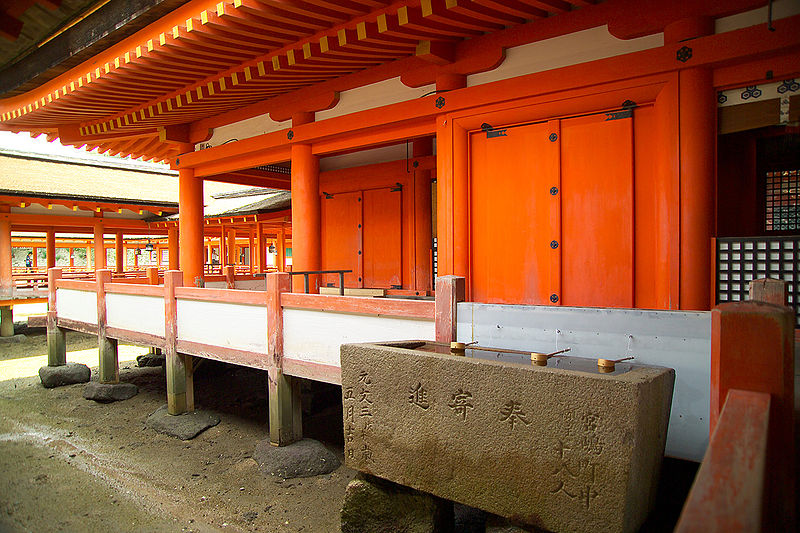Hiroshima (広島市) is the capital of Hiroshima Prefecture in western Honshu, the largest island of Japan. The city's name, 広島, means "Broad Island" in Japanese. Hiroshima is best known as the first city in human history to be targeted by an atomic bomb towards the end of the World War II. The was rebuilt after the war. Today it is a city full of vitality and purpose.
Hiroshima-shi
Hiroshima Peace Memorial Park is a memorial park and a prominent feature in the center of Hiroshima. It is dedicated to the legacy of Hiroshima as the first city in the world to suffer a nuclear attack, and to the memories of the bomb's direct and indirect victims (of whom there may have been as many as 140,000). There are a number of memorials and monuments, museums, and lecture halls, which draw over a million visitors annually. The annual Peace Memorial Ceremony is also held in the park. The area is served by Light Rail Line 2,3,6 and 7 at Gembaku-Dome-Mae Station.
The Hiroshima Peace Memorial Museum is the primary museum in the park dedicated to educating visitors about the historic event. Exhibits cover the buildup to war, the role of Hiroshima in the war up to the bombing, and extensive information on the bombing and its effects, along with substantial memorabilia and pictures from the bombing. The building also has views of the Memorial Cenotaph, Peace Flame, and A-Bomb Dome.
The Atomic Bomb Dome, also known as the Hiroshima Peace Memorial, is part of the Hiroshima Peace Memorial Park and a designated a UNESCO World Heritage Site. The ruin serves as a memorial to the people who were killed in the atomic bombing of Hiroshima on 6 August 1945. Over 70,000 people were killed instantly, and another 70,000 suffered fatal injuries from the radiation. The building was the only structure left standing near the bomb’s hypocenter. Ultimately, when the reconstruction of Hiroshima began, the skeletal remains of the building were preserved.
The Hiroshima Museum of Art is an art museum founded in 1978. The collections consist mainly of Japanese oil paintings from after the Meiji Period to modern times; and modern European paintings with a focus on French Impressionism.
Okonomi-mura (Okonomiyaki Village) is a Hiroshima-style okonomiyaki food theme park. In Hiroshima, the ingredients are layered rather than mixed. The layers are typically batter, cabbage, pork. Noodles (yakisoba, udon) are also used as a topping with fried eggs and a generous amount of okonomiyaki sauce. Okonomi-mura has 24 okonomiyaki restaurants, each with a slightly different style and set of ingredients. The restaurants use a specialty okonomiyaki sauce created only for Okonomi-mura.
Hiroshima-shi, Hatsukaichi-shi
Hiroshima Castle, sometimes called Carp Castle, was the home of the daimyō (feudal lord) of the Hiroshima han (fief). The original castle dates back to the 1590s, but was destroyed by the atomic bombing in 1945. It was rebuilt in 1958, a replica of the original that now serves as a museum of Hiroshima's history before World War II. After the abolition of the feudal system during the Meiji Restoration (1869), the castle came to serve as a military facility, and the Imperial General Headquarters was based there during the First Sino-Japanese War. The castle can be accessed by Light Rail Line 1,2 and 6 at Kamiyacho-nishi Station.
The Hiroshima Prefectural Art Museum is an art museum founded in 1968. Its collection has over 3500 art works associated specifically with Hiroshima prefecture. Other Japanese and East Asian art crafts and works from the 20s and 30s are also featured.
Shukkei-en is a Japanese style garden with a long history. Construction of the garden began in 1620 during the Edo period at the order of Asano Nagaakira, daimyo of the Hiroshima han. Since the Meiji period, the garden served as the villa of the Asano family. During the nuclear attack in 1945, Shukkei-en suffered extensive damage, and then became a refuge for victims of the war. After renovations, it reopened in 1951.
Itsukushima Shrine is a Shinto shrine on the island of Itsukushima (popularly known as Miyajima), best known for its "floating" torii gate. The shrine complex is a UNESCO World Heritage Site. The very first shrine buildings were probably erected in the 6th century and the present shrine dates to the mid-16th century. The shrine was designed and built on pier-like structures over the bay so that it would appear to be floating on the water. The dramatic gate, or torii, of Itsukushima Shrine is one of Japan's most popular tourist attractions, and the most recognizable and celebrated feature of the Itsukushima island.



























